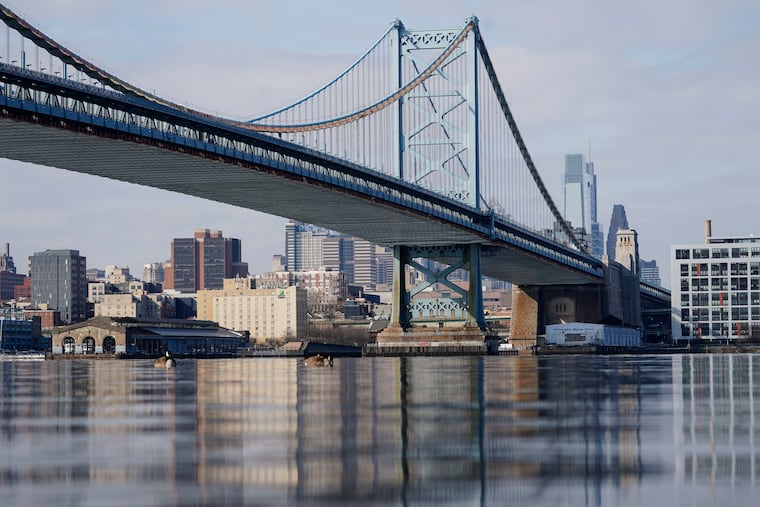Low oxygen levels in Delaware River emphasizes need for more protection, environmental group says
Though pollution in the Delaware River is nowhere near as bad as it once was, a new report showing dips in on oxygen levels in the water the past two years is concerning say environmentalists.

Though pollution in the Delaware River is nowhere near as bad as it once was, a new report showing dips in oxygen levels that fish depend on for survival demonstrates a need for more protection, says the Delaware Riverkeeper Network, a nonprofit environmental advocacy group.
The organization, which issued the report Wednesday, and a coalition of 16 other environmental organizations have already petitioned the Delaware River Basin Commission, an interstate regulatory agency, to upgrade the river’s status from “maintenance only” to “maintenance and propagation,” which would include regulations that are protective of aquatic life including species such as striped bass, American shad, and the federally endangered Atlantic sturgeon, all of which have made comebacks in recent years.
Much of the 133-mile-long river already has the upgraded protection. A 20-mile-long tidal zone from Philadelphia to Wilmington, however, does not. Every summer, the report found, that zone experiences low levels of dissolved oxygen, a measure of the amount of oxygen in water, that can damage fish survival.
The Riverkeeper Network said that even a moderate improvement in the situation could mean up to $60 million annually in economic benefits to the region, including increased property values in communities along the river, commercial fishing activities, and recreation. For example, low levels of oxygen in the water can create odor that can drift over communities in Philadelphia, Camden, and Wilmington, hurting property values. Higher levels can also lure in more anglers because the fish population is healthier.
Dissolved oxygen levels should be at 5 milligrams per liter or above to protect aquatic life, the report says. Anything below that is considered a low level of dissolved oxygen. Decades ago, levels reached zero, creating an infamous dead zone. But regulation helped restore oxygen to healthier levels, bringing back fish that had disappeared.
Last summer, however, dissolved oxygen fell to 2.8 in the river near Chester and 3.3 near the Ben Franklin Bridge, according to sensor readings. Similar events occurred in 2019.
Erik Silldorff, restoration director at the Delaware Riverkeeper Network, called those “lethal levels.”
Oxygen levels are typically at their lowest in summer because of the impact of temperatures. But the report cited rising temperature due to climate change.
“The problem is that while we have this dramatic success ... we haven’t finished the job,” said Maya van Rossum, leader of the Delaware Riverkeeper Network. “We accomplished a lot and then we sort of stagnated.”
She urged the DRBC to upgrade protections, saying it has stalled doing so for years.
The DRBC issued a statement saying that it passed a resolution in 2017 to review dissolved oxygen criteria in the urban portion of the Delaware River Estuary. The commission is working with state and federal regulators on studies “to address the complex science that could support revisions to the aquatic life uses and water quality criteria consistent with the Clean Water Act goals,” according to the statement. The DRBC says it has kept the public informed throughout the process.
The biggest culprit in reducing oxygen levels is wastewater treatment plants, particular those owned by the Philadelphia Water Department, according to the Riverkeeper Network. The PWD’s plants were built decades ago and did not include a way to get rid of the large amounts of ammonia in human waste.
The ammonia gets converted into nitrogen by microbes in the river. Nitrification causes oxygen levels to dip.
But requiring aging plants to upgrade can be costly.
Brian Rademaekers, a spokesperson for PWD, said in an email that the department is working with the DRBC to “evaluate the scientific, technical, social and economic factors that affect attainability of higher levels of dissolved oxygen in the estuary.”
PWD will use the research to understand what types of modifications would be needed at the city’s three main water pollution control plants.
“Given the potential costs for complete facility overhaul,” Rademaekers wrote, “... PWD is actively designing a new, specialized sidestream treatment facility at our Southwest plant to reduce approximately 10% of its total ammonia load to the estuary.”
The project would address ammonia before it reaches the plant, making it more cost effective than a full upgrade, he wrote.